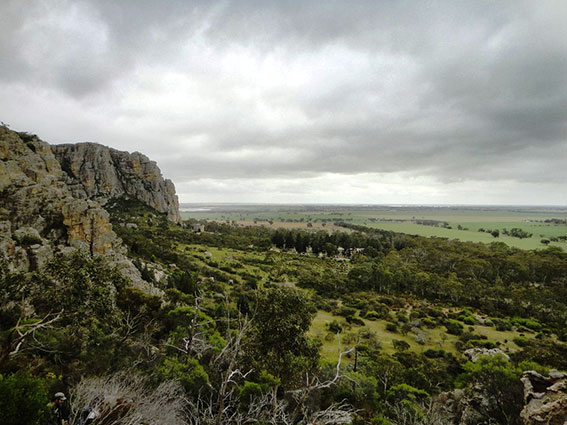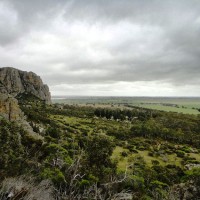 As many of our readers will have noted, the staff at Open Spaces are involved in various aspects of the outdoor industry. Whilst OSP is a big part of our lives, the reason why we are here in the first place is because of our interest and experiences in that area. Besides climbing, one of my other jobs feeds very well into my OSP role. Working as the VCC Access and Environment Officer for the climbing community allows me to get involved not only in helping to maintain access for climbers at the many parks but also to work on projects at the cliff environment. One such project that I am working on currently has been ongoing for about 4 years now. The Pharos Gully Repair project is a labour intensive one – to dry stonework the entire Pharos Gully Track from bottom to summit. The track is used by climbers and walkers alike and due to its steep nature, the erosion is quite severe with further loss of vegetation creeping out wider and wider. So with the help of some funding from Parks Victoria, CliffCare and Friends of Arapiles have rounded up regular volunteers to help out at the working bees to move rock up and down the track so that the stonemason can work his magic.
As many of our readers will have noted, the staff at Open Spaces are involved in various aspects of the outdoor industry. Whilst OSP is a big part of our lives, the reason why we are here in the first place is because of our interest and experiences in that area. Besides climbing, one of my other jobs feeds very well into my OSP role. Working as the VCC Access and Environment Officer for the climbing community allows me to get involved not only in helping to maintain access for climbers at the many parks but also to work on projects at the cliff environment. One such project that I am working on currently has been ongoing for about 4 years now. The Pharos Gully Repair project is a labour intensive one – to dry stonework the entire Pharos Gully Track from bottom to summit. The track is used by climbers and walkers alike and due to its steep nature, the erosion is quite severe with further loss of vegetation creeping out wider and wider. So with the help of some funding from Parks Victoria, CliffCare and Friends of Arapiles have rounded up regular volunteers to help out at the working bees to move rock up and down the track so that the stonemason can work his magic.  We employed Walter Braun, who is a climber himself and an experienced stonemason to dry stonework the track. At about 2/3rds completed, the track is looking great and some of the sections completed a few years ago are now ageing well with vegetation growing in and around the stonework. And this is exactly what we want and why dry stonework is the way to go.
We employed Walter Braun, who is a climber himself and an experienced stonemason to dry stonework the track. At about 2/3rds completed, the track is looking great and some of the sections completed a few years ago are now ageing well with vegetation growing in and around the stonework. And this is exactly what we want and why dry stonework is the way to go.
Arapiles has had a great last year and a half. Of course we are heading into winter now and at this time of the year, everything usually is starting to look green. What was amazing to see though was the greenness that continued throughout summer this year. Granted the floods brought a huge amount of water to the area but before that Arapiles and its surrounds were still getting a regular fall. In previous years, throughout the drought, the mount had lost a lot of older trees. They held on for as long as they could, but there were many that were stressed to the point of no return. With the rains, came the opportunity for new vegetation to get a good watering in. CliffCare and Friends of Mt Arapiles revegetated a number of areas with plants supplied by Iestyn Hocking and Heather Phillips who collect seed and grow indigenous plants and grasses from the area. Many of these plants are now thriving and can be seen along the lower part of the Pharos Tourist track. As the old pines are dying in the Pines campground at Mt Arapiles, they are being removed. Rather than replant with the original Radiata pines, native callitris pine seedlings were planted in 2008. These are all healthy young plants now. To protect them further as they grow, stakes and chicken wire were placed around them to ensure that they can stand up to the many campers that the campground sees.
Even if you don’t climb, Arapiles really is a magical place to visit. From its birds of prey to the small robins and bee eaters. Shinglebacks and frilled neck lizards and occasionally a goanna or two. Wallabies, cockatoos, lorikeets. And with 500 native species in the park, you could certainly tick off a few sightings in your flora book. It has them all really. It really is a special place and one that needs to be carefully preserved.


